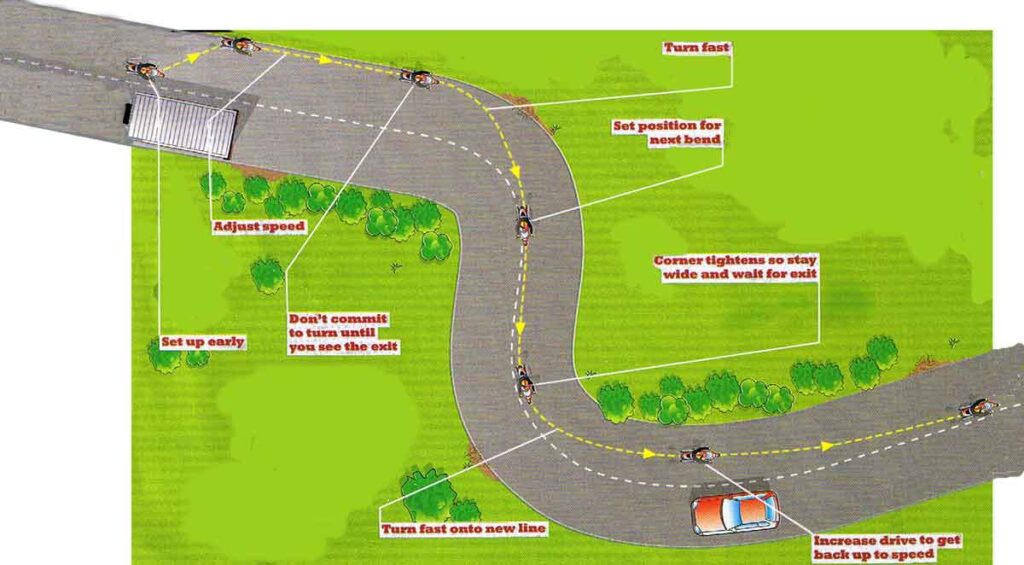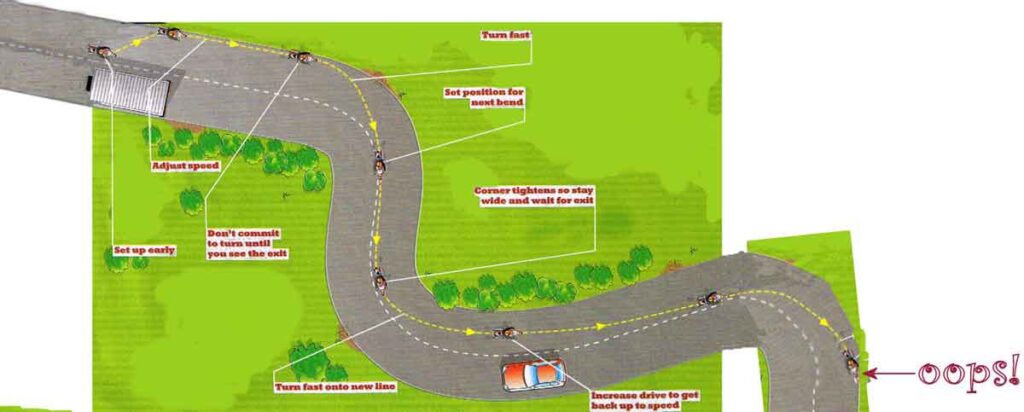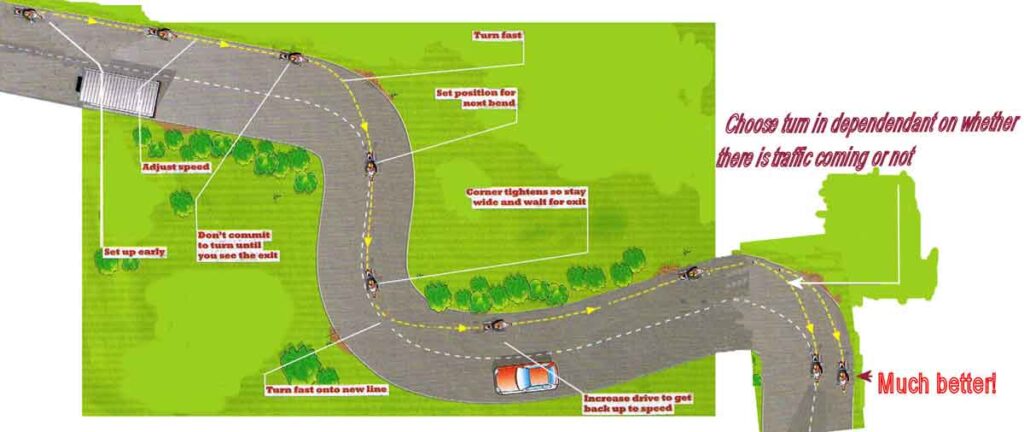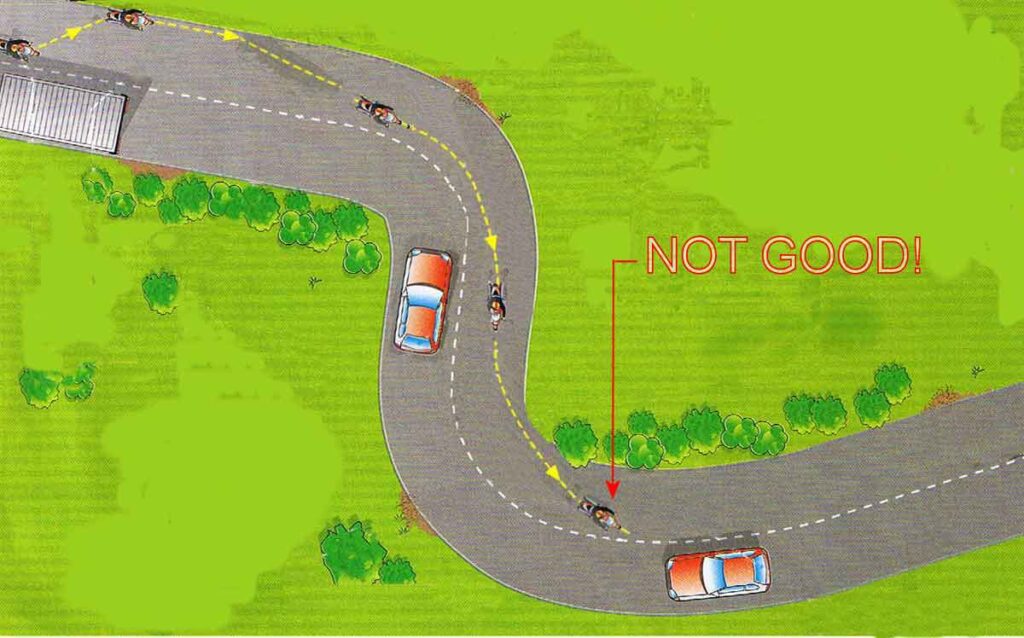Going Round Corners
Pete the Free teaches his grannie to suck eggs…
Bearing in mind my record of falling off I am perhaps not the person to be writing this, but I have now witnessed, and been nearby, on too many occasions when a fellow rider has come unstuck on a corner. I have followed many people now and there is a consistent, persistent and dangerous combination of errors that appears almost universal. I also make these errors (but am at least aware that I make them).
I have shamelessly stolen the basis of my drawings from Bike magazine riding tips articles. These are pretty good, but as I hope to illustrate below, could be better.
Common cornering errors
First and foremost comes too high an entry speed. One can get round a corner with too high an entry speed but survival is dependant on whether or not one’s GUESSES about corner conditions are right or not. The next most common is too early a turn in which tends to cause running wide on exits. Slightly less common is too late a turn in, the end result of which is highly dependant on entry speed. Too fast an entry speed in my opinion tends to arise from following the rider in front rather than making a bend assessment for oneself. Too early a turn in is extremely common and presumably comes about through being over anxious to begin the turn. Too late a turn in is just bad timing!
Too high an entry speed and too early a turn in (extremely common combination) will tend to lead to running wide (in varying degrees) on the exit to the bend. Mostly this just leads to the bike approaching the kerb or the white line and appears harmless. However, survival in this situation becomes luck and not judgement. A dangerous road surface near the kerb will lead to disaster, as will a car cutting the corner when running out to the white line.
I shall try to illustrate these points with both drawings and video clips:


This is a common scenario. When bends are linked together small errors can add up until they become unsustainable and very dangerous.

The set up is much earlier, why wait? The turn in at the second bend has set the rider up for the third bend nicely and put considerable space between the car and the rider. The turn in for the third bend demonstrates the flexibility that should always be applied according to approaching traffic and/or if there is a fourth bend either to the left or the right. The correct position can be achieved accurately and early. Should a car be approaching that may cut any of the corners above it will be seen early and avoided.

How to get it right
The key to successful cornering is an approach speed that allows full bend assessment before turn in, correct gear selection to allow drive through then out of the corner, then turning in when FULL visibility has been achieved. If this last part is not possible you entered the bend too quickly. It is very common for me to be left behind on the entry to a bend but to be all over the bikes in front at the end of a series of bends. Remember SLOW IN, FAST OUT.
Some example of could-be-better cornering
Here we have Sally who tends to turn in too early. In this video, a series of three bends, the first two early turn ins appear harmless but cause her to be badly exposed to oncoming traffic in the third bend which is then followed by the classical drift out towards the kerb. Note the position of the camera compared with Sally in the third bend.
In this second clip an early turn in on a left hander leads to running wide and crossing the centre line. Fine if it is deliberate, dangerous if not.
Both of these would be solved by a lower entry speed, a faster, later turn in and probably a lower gear.
Now Sally herself says she is inexperienced, however even experienced and normally excellent riders can make mistakes.
Here we have Chris performing late turn ins. In the first 2 bends it is easy to manage but by the fourth bends he has to perform a fairly heroic “flick” to make it safely. Of course being as smooth as he is he makes it look easy, it isn’t. In the first bend, because of the late turn in, he is unnecessarily exposed to traffic
I think everybody makes the occasional error (though I can’t recall seeing Robbie making a mistake), here is one of mine. Too early a turn in on a closed throttle on an uphill hairpin requiring a mid-corner correction bleargh.
Commentary on the video of series of well-strung together corners
My position on the approach to the first left hander is not very wide as it is a gentle corner and there is good visibility. On approach to the first right hander I am well to the left as it is significantly tighter. Hard turn in then a deliberate drift over the line to improve my view of the next left hander. However the next left hander is clearly a long bend so I abandon the very wide view and come back to the left of the mid line. Staying wide all the way round the bend until I can see the exit. I drive hard at the exit and come to the very left hand edge just after the hazard of the small junction on the left. Hard turn in for the right bend then immediately drift left as the next bend is to the right again.. Not quite such a hard turn in for this next right as there is traffic approaching. I am aiming for the centre line as the second car passes.
